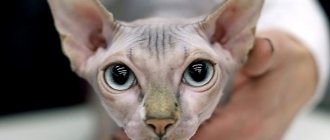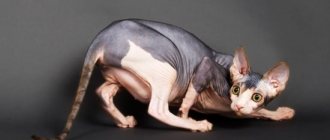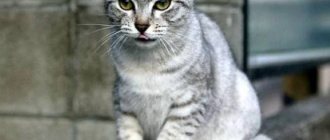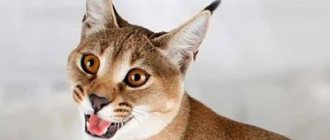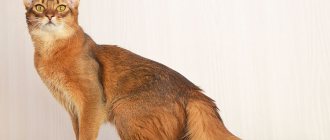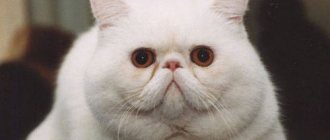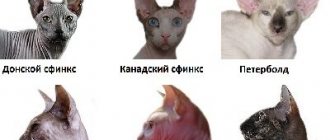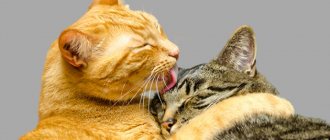The history of hairless cat breeds
1830
Naturalist Johan Rudolf Rengger described South American cats as completely hairless.
1903
A pair of hairless cats (Nelly and Dick) was bought from the Indians of Mexico. The leader of an Indian tribe claimed that bald cats were a special Aztec breed. There were no offspring from Nellie and Dick.
1975
A classic cat gives birth to a non-standard hairless kitten, which its humorist owners dubbed Epidermis.
1987
Rostov-on-Don. Elena Kovaleva finds an almost hairless cat on the street, later named Varvara. From mating with the shaggy cat Vasily, Varvara consistently produced regular and hairless kittens in her litter.
Character and habits
Many people are disdainful of owning a Sphynx - they are repelled, first of all, by their unusual, in some ways even frightening, appearance. However, having gotten to know them better, most of the ardent opponents literally fall in love with these animals, joining the ranks of their fans.
This is not surprising: it is difficult to find a breed more attached to its owners. Sphinxes did not at all inherit the capricious disposition of their Siamese relatives. They are absolutely not vindictive, fearless, and so affectionate that they are ready to stay in their owner’s arms around the clock just to be petted.
Those who decide to have a hairless pet in their home need to remember several important features of their character:
- Hairless cats love affection and attention. They constantly reach out for hands, and at any opportunity they try to jump onto the lap or sit closer to the owner.
- They take particular pleasure in touching their muzzle. They love to have their ears rubbed, the area around their eyes scratched, and a kiss on the nose will make them absolutely happy.
- If you have guests, be prepared for the fact that your pet will be gentle with everyone who comes to the house. Hairless cats are not at all scared by strangers; they happily offer their sides for scratching, purr loudly and express their pleasure.
- These animals have great affection for their owner. Unlike their furry relatives, they are not prone to individualism. They remember their owners instantly and are distinguished by devotion, which is more typical for dogs.
- Hairless cats are very smart. They instantly remember the place to feed and their own name; you can train them to use the tray in one or two times. They memorize new commands effortlessly, so don’t be surprised if a clever tailed dog brings you slippers or demonstrates the wonders of training.
- And, surprisingly, they do not know how to be capricious at all. Outwardly eccentric, they are very calm and conflict-free.
- This breed is great for families that already have other animals or small children. “Moon cats” are very friendly to everyone around them; they get along calmly with dogs, turtles and guinea pigs.
The main problem that owners of hairless cats face is their sociability. They absolutely cannot stand loneliness. If a sphinx has settled in your house, you will have to forget about closed doors. Left alone, the cat will be sad, meow and try to get out of the room. It is quite possible that this could end not only in stress for the animal, but also in damaged furniture and wallpaper.
Hairless cat breeds with photos
There are 9 breeds of hairless cats in the world. Each of them has unique appearance and character traits, and they are united by a complete or partial absence of fur.
Peterbald
The Peterbald is an affectionate and gentle creature with a surprisingly soft and responsive character . The breed got its name from the English peterbald, which means “bald Peter,” which was inspired by the creator of the breed, Olga Sergeevna Mironova, when she saw a sculpture of Peter the Great resting in the Peter and Paul Fortress. The breeding program included Russian Blue and Siamese cats. Despite the fact that the Peterbald belongs to the group of hairless breeds, there is a short, only 2 mm, velor fluff on its body, which is very soft and pleasant to the touch.
Males weigh 4.5-7 kg, females 3.5-5.5 kg . Peterbalds have large, round-tipped ears and a wedge-shaped muzzle, a lean build, and a prominent chest. Life expectancy is 13-15 years.
St. Petersburg Sphynxes are inquisitive and intelligent, cheerful and active, people-oriented, need warmth and care , and even suffer from lack of attention. Animals are not vindictive, they will never act out of spite, sometimes they prefer to retire to a secluded corner, despite the energy that is overflowing. Developed intelligence helps the cat to quickly grasp the owner’s mood. Peterbald always knows what they want from him and rarely contradicts. He expresses his emotions with a loud voice and rumbling.
The Peterbald breed of hairless cats gets along well with other pets and gets along with children if they behave correctly . Peterbalds have a hard time with changing their place of residence and take a long time to get used to the new environment.
Canadian Sphynx
The Canadian Sphynx is the oldest breed of hairless cat, a legend of its kind, existing for more than half a century . The alien appearance leaves few people indifferent. In addition, cats are distinguished by their friendly, loving, and responsive character.
“Canadians” have large, sensitive ears, an elongated body and paws, a wedge-shaped muzzle , and large, expressive, bewitching eyes. Males weigh 4-7 kg, cats 3-4 kg, live on average 12-15 years.
Animals love to be the center of attention and everyone's admiration . They are ready to sell their souls for this! The cat will do anything to make the owner take his mind off the important matter and turn his attention to her. But this is by no means a star fever, sphinxes simply love to contact people, bathe in love and affection. Breeders strongly recommend limiting your cat's desire to sit in your arms from an early age, otherwise you will have no peace.
Hairless cats of the Canadian Sphynx breed are active, playful, ready to participate in household chores, and do not like to be left alone for a long time , so you will have to take them with you on any long trip. Even if the cat is left with people he knows, he will be overcome by sadness and longing. Representatives of the breed get along well with children, are friendly towards strangers, and are extremely devoted to their family. Bald rascals love to fool around, which reminds them of children.
Don Sphynx
The Don Sphynx is an extraordinary breed in many ways. The unusual appearance immediately attracts attention : a wedge-shaped muzzle, triangular-shaped ears, absence of eyebrows, twisted whiskers, elongated body and paws, expressive, bewitching eyes. The board of the sphinx resembles an alien inhabitant who accidentally ended up on Earth.
Males weigh 4-5.5 kg, cats 2.5-4.5 kg . Life expectancy is 11-13 years.
Hairless cats of the Don Sphynx breed are gentle and affectionate, extremely people-oriented, and sometimes overly intrusive . They cannot tolerate loneliness, they suffer and are tormented by mental anguish if the owner is not around for a long time, and this entails neurotic disorders.
Don Sphynxes love children and get along with other pets. Cats are active and mischievous, easily accustomed to a tray and leash, and learn simple commands.
Bambino
The Bambino is a new “designer” breed, created in 2005 as a result of crossing the Canadian Sphynx and the Munchkin. The breed has not yet received official status. TICA has provisionally registered the Bambino as an experimental breed. In Germany, the breeding of these cats is punishable by animal protection law.
Important! American cats and those that live in the CIS countries and the Russian Federation have different origins. In the CIS, the breed began to be bred in the Baby Moon Cattery nursery, but the Americans Stephanie and Pat Osborne were the first. The couple acquired a kitten with a non-standard physique and decided to start breeding such cats. The name of the breed was chosen based on the general impression that the kitten made on them.
A distinctive feature of the breeds is short limbs with relatively large ears. This gives cats a special charm. The animals move in a very unusual way, which makes them resemble clumsy kids. The bambino's body is small, its tail is thin, and its skin is velvety to the touch.
Males weigh 2-4 kg, females 2-3.5 kg . Life expectancy is 12-14 years.
By nature, bambinos are responsive and affectionate, simple-minded and playful, boundlessly devoted to their family . Cats can be capricious, but this is due to the peculiarities of caring for them. Breeders claim that the manifestation of dissatisfaction is an acquired quality rather than hereditary.
Cats become strongly attached to their owners, try to be nearby all the time , and love to accompany family members on trips and trips. Bambinos love children and can play with them tirelessly.
Dwelf
Dwelf is an unusual breed, attracting attention with the length of its limbs and special physique . These cats are like creatures from another world. However, the breeders sought exactly this effect. The breeding program included: Canadian Sphynx, Munchkin and American Curl.
Breeders encountered difficulties, since at first it was not possible to obtain a cat that was ideal in all characteristics. Only in 2009, the first Dwelf kitten was born - ideal in all respects.
Representatives of the breed are small in size : males weigh 2-2.5 kg, females 1.5-2 kg. Life expectancy is 10-13 years. the body is elongated, the limbs are short, the tail is long, the muzzle is wedge-shaped, the ears are erect, the eyes are large and expressive. The fur is completely or partially absent - the body is covered with fluff that is invisible to the eye.
Dwelfs have absorbed all the best from three breeds: a soft and calm character, lack of aggression, friendliness and love. These are soft and good-natured creatures, extremely attractive and affectionate, moderately curious and active, and are friends with dogs and other pets.
Cats get along with children and love active games . But the child should be explained that the animal must be handled with care and not thrown to the floor from a height, since due to its short legs, the Dwelf does not know how to land correctly. In addition, a cat's skin is delicate and sensitive to scratches and other damage.
Elf
Elf is a breed with an unusual appearance .
There is no other one like it in the world. The breeding involved the Canadian Sphynx and the American Curl. Elves have a unique appearance, but share similarities with other hairless breeds. This is a very rare breed that is suitable for people with allergies. These cats are allowed to be crossed with the Canadian Sphynx .
In this case, half of the kittens are born with normal ears, and half with curled ears. The most valuable is considered to be the crossing of two elves, which allows maintaining the breed standard. Elves have a thin build, a medium-length tail, large ears and expressive, hypnotic eyes , a wedge-shaped elongated muzzle, and folded skin. Wool is completely or partially absent. Males weigh 3.5-4.5 kg, cats: 2.5-3.5 kg. Life expectancy 12-16 kg.
By nature, elves are affectionate and gentle, sometimes they can be capricious . Cats need love, affection and constant attention from their owners.
Reference. Elves love to play with children and get along well with other pets.
These animals are extremely curious and love to poke their bald little faces into all household chores . Strangers are greeted friendly and openly.
Ukrainian Levkoy
The Ukrainian Levkoy is a rare breed of hairless cat that is just gaining popularity . These are perhaps the only fold-eared hairless cats in the world. The breeding involved the Don Sphynx and the Scottish Fold cat.
Representatives of the breed are of medium size, drooping ears, long and thin paws , a convex chest, a wedge-shaped mora, and folded skin. Males weigh 3-5 kg, females 2-3.5 kg. Life expectancy is 12-14 years.
The character of the Ukrainian Levkoy is friendly, gentle, and patient . The cat loves attention, but is not intrusive in itself. If he feels that his owner is not feeling well, he will simply lie down next to him and purr.
Cats are highly intelligent and easily adapt to new environments. They are cheerful and active, love to play pranks, and get along well with children and other pets.
Kohana
Nature itself is responsible for the appearance of the Kohana breed. Its first representatives appeared in Hawaii and were called kohana , which means “bald” in Hawaiian.
Their amazingly delicate skin looks like melted wax, it is soft, velvety and slightly wrinkled. Cats do not have hair follicles, so hair does not grow under any circumstances. The second name of the breed is the Hawaiian hairless cat. There are only a few individuals in the world, so the breed is classified as rare. The Kohana's body is muscular and strong, the belly is convex, the chest is wide, the tail is curled into a ring, and the skin is highly folded .
Kittens have so many folds on their faces that sometimes their eyes are not visible, but this goes away with age. The skin is warm and elastic, covered with a protective lubricant. The head is wedge-shaped, pronounced cheekbones and chin, almond-shaped eyes, straight nose, large ears. Males weigh 3-6 kg, females 2.5-4 kg . Life expectancy is 12-13 years.
Breeders claim that this is the most human-oriented breed , with a character more reminiscent of dogs. The Kohana breed of cats without hair are extremely curious, but at the same time calm, indifferent to games.
Cats enjoy spending time on their owner's lap. Kohanas can be persistent if the owner does not pay due attention, and can sometimes be capricious.
Minskin
The Minskin breed was created in 2001 in Boston by crossing a Sphynx, a Longhaired Munchkin, a Burmese and a Devon Rex. The result of this fusion of breeds was cashmere, barely noticeable hair on the body, shaggy ears and paws. The name of the breed comes from the merger of two English words: miniature - “miniature” and skin - “skin”.
Minskins are very similar in appearance to bambinos, but differ in the type of coat . The breed is still not recognized, but its development is monitored by TICA.
Representatives of the breed are miniature but extremely energetic creatures . These are intelligent and intelligent animals, human-oriented. Minskins love to greet their owners from work, and when they are late, they begin to worry and feel sad. Cats are trusting and sociable, they care about everything. They get along well with children and are friendly with dogs.
Average weight 1.8-3 kg , life expectancy 12-15 years.
Keeping hairless cats
If you want to buy a hairless cat, then it is important to understand that such pets should not be left to their own devices, they definitely need attention and good care. Their health needs constant monitoring, because wool will no longer serve as protection from external factors. If you are a too busy person, then you should not make life difficult for either your pet or yourself - after all, both kittens of hairless cats and adults take up a lot of time. Such an animal requires living in a warm place - they tend to freeze and do not have the opportunity, like other cats, to warm up under their own thick fur coat. Such pets can often be seen next to a radiator or heater. To prevent skin burns, caring owners place a thick cloth on the cat’s favorite place. Carefully walk hairless cats - the sun's rays can also burn the skin, and the absence of hair does not in any way protect the body from a shock dose of ultraviolet radiation. The time for walks is calculated so that the cat does not walk under the scorching sun.
Sphinx food
Perhaps one of the most unusual features of the Sphinx is its excellent appetite. Such a cat does not think about her figure: she loves everything and more. The reason is increased metabolism due to high body temperature and “baldness”.
The ideal diet for a Sphynx is 80% natural products to 20% feed, or vice versa. However, not every owner can correctly balance a natural menu for a cat. Ready-made food can help.
Elite breeders keep Sphynx cats on the following diet:
- meat (boiled chicken, raw beef, boiled or raw beef liver) - about 60%;
- dry food (for example, Hills, James, Eagle Pack) - 20%;
- milk (ryazhenka, cottage cheese, milk, semolina porridge with milk) – 5%;
- boiled egg or raw yolk – once a week;
- treats (depending on individual preferences) - approximately 1%.
Sphynxes are more likely than other cats to become hooked on unusual foods - cucumbers or chocolate. Pamper your pet by remembering the 1%.
Rules for choosing a Sphynx kitten
You can buy a purebred Sphynx kitten only in a specialized nursery. Information about trustworthy breeders is available on their official websites. You can also choose a real sphinx at exhibitions.
At cat shows you can purchase a Sphynx kitten from reliable breeders
Criterias of choice
Once you are convinced of the breeder's reputation and have decided to purchase, it is worth observing the kittens in their familiar environment. This way you can choose a pet of a suitable temperament and understand its physical condition. The kitten should be agile and playful, sociable and easy to make contact with.
Healthy little ones should not shake their heads or scratch their ears. The kitten's eyes and ears should be dry and free of discharge. The animal should not have a bloated abdomen, it should not cough, sneeze, or be lethargic or lethargic. If you notice signs of illness in at least one of the individuals present in the nursery, you should refuse to purchase.
A responsible breeder is obliged to provide a certificate of registration of the cattery, information about the pedigree of the parents, diplomas about their receipt of various awards and, of course, present the mother cat herself.
When purchasing a pet, a sales contract must be drawn up. Along with the animal, the breeder must submit a birth certificate, pedigree and veterinary passport.
At what age is it better to buy a Sphynx?
Pedigree animals are usually considered ready for sale when they reach 3 months of age. Such kittens are already ready to be separated from their mother and have mastered the first necessary skills. By this time, the course of vaccinations ends and it becomes possible to assess how well the pet meets the breed standards.
Don Sphynx
This breed was formed in Rostov-on-Don, and at one time was called “Russian hairless”. Although in fact, Don Sphynxes come with different types of skin - among them there are not only completely bald individuals, but also individuals with light soft fluff (flock and velor type) and rare coarse hair (brush type). On the skin of sphinxes, like a tattoo, patterns of different colors appear. The eyes of these cats are almond-shaped, similar to those of a hare. The head, neck and groin area are covered with folds. The skin is very soft and warm, almost hot. In “flocked” individuals it is covered with light fluff and feels like a peach.
Character of hairless cats
Hairless cats have a playful disposition and love to be the center of attention. Representatives of hairless breeds do not tolerate loneliness well. They have special love and affection for one person, but the pet is affectionate with other household members and takes part in children's games.
Due to their cheerful, non-conflict disposition, they get along well with children. Representatives of hairless breeds are sensitive to the owner’s condition and are always ready to cheer him up.
Animals are well trained and understand human speech. It will not be difficult to accustom them to a routine in the house.
Elf
The name of these animals comes from their unusual ears. They are not like all kittens! The ears of such cats are large and turned back, which is why they resemble fantastic elves. Since they are hairless, they occupy a place on the list of hairless cats.
To develop such breeds, Sphynxes were crossed with Curls (American). At the beginning of the 20th century, scientists began to make such a product, but only in 2007 in the United States of America this breed of cat became known to everyone.
But to this day there is no official calling for this type of cat.
Owner reviews
Ori owners are unanimous that they are very smart, quick-witted and talkative cats. According to them, they will respond to any request, any action is accompanied by some kind of sound, purring or meowing. The owners also confirm the immense sociability of Orientals and their reluctance to remain alone - they want to participate in everything, they often climb on the owner’s shoulder, wanting to control any process. They protest against loneliness by howling and meowing - all the owners of oriental beauties talk about this.
Only in relation to children the reviews differ. Some Oriental cats allow themselves to be cuddled, especially if the ori and the child grow up together, while other owners simply hide from the children or watch them from above.
Basically, of course, owners of Orientals are sure that it is impossible not to fall in love with this breed of cat, especially if there is not enough communication - with an Oriental cat you will forget about loneliness. And many consider the minimum wool and lack of smell to be an undoubted advantage.
Conclusion
Of course, if you are away from home for a long time or you don’t like “loud” cats, the oriental will not suit you. But if you need a cat who is as loyal as a dog, sociable and smart - get an Oriental! You definitely won't be bored with him.
Petersburg Sphinx
Two breeds took part in the creation of the Peterbalds - the Don Sphynx and the Oriental cat. From the first they took a bald body, from the second a narrow elongated head, graceful legs, and a slender body. The St. Petersburg Sphynx is not completely bald. His body is covered with a “suede” undercoat. Short hairs can be on the tail, paws and muzzle. Sometimes there are whiskers (usually hairless cats do not have them) and eyebrows.
Prices for kittens of hairless breeds
The price of a kitten will depend on its class and pedigree.
If you do not plan to participate in exhibitions or breed hairless cats, you can save money and purchase a pet-class pet. They have slight deviations from the breed standard, but they will only be noticeable to a felinologist. The average price for a pet starts from 6,000 – 10,000 rubles. Show class will cost from 50,000 rubles.
The cost of Don Sphynx kittens starts from 6,000 rubles, Canadian – 13,000 rubles, Peterbald – 9,000 rubles.
Bambino
The first hairless kitten with short limbs was born after an accidental mating between a Munchkin and a Canadian Sphynx. In 2005, he came to the American breeders of the HolyMoly Cattery nursery. The breed is gaining popularity; the TICA organization recognized it as experimental. At the same time, breeders from Boston bred similar cats; they added the genes of the Burmese cat and Devon Rex. This variant was called “minskin”; some felinologists consider it a subspecies of bambino.
